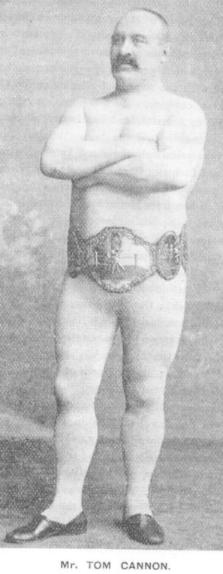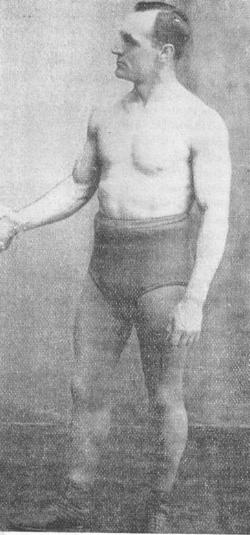Sandow’s Magazine of Physical Culture, April 1902

I SHOULD like to remark at once, to prevent disappointment, as they say in the advertisements, that I am not an authority on the subject of wrestling. I have never wrestled myself except with my conscience, and though on such occasions I invariably won, I feel that this can scarcely entitle me to speak of myself as an expert. However—
When I say the Halls, I mean the hall, the Tivoli to wit, where Tom Cannon, world’s champion Græco-Roman style, and Jack Carkeek, world’s champion catch-as-catch-can, nightly took on all who cared to try their skill. Also the offer of a £10 note (beg pardon, I should say, of course, a crisp £10 note) to any one whom they fail to defeat at their own particular style within a space of 15 minutes. That, at least was the original offer. But on the night I added my distinguished self to the audience, strictly incog., Mr. Carkeek announced a change. In future the challenger would receive £1 for every minute he survived after the expiration of the first 10. That is to say, if he was beaten in 10 minutes he would get nothing but sympathy. If he lasted 11, he would receive £1, and so on. But to get to the performance.
I was particularly anxious to see some wrestling. I had seen some boxing. There had been a round or two among the audience earlier in the evening, purely an amateur affair but very spirited, a three-cornered fight between a lady and two gentlemen in the pit-stalls. When this was over, my blood was up. I wanted excitement. I counted the minutes to the wrestling. At last the curtain went up. A gentleman in evening-dress came on and began to speak. “Where have I seen that face before?” I murmured to myself. Then I knew. “Why, it’s Sherlock Holmes;” But it wasn’t. It was Mr. Jack Carkeek. Except that he is broader and thicker than the great detective, they might pass for one another anywhere.
Mr. Carkeek made a very good speech. But I objected to his statement that neither he nor his fellow-champion would hurt their opponents. I was disappointed. As I said, my blood was up, and when that happens I must see something broken, preferably some one else’s anatomy. Failing that, I can put up with the breaking of a silence.
Mr. Carkeek retired amidst applause, and the timekeeper and referee, both looking as if they had lost their way somehow and wearing on their faces a sort of “Dear-me-I-thought-this-was-Exeter-Hall” kind of expression, stole furtively in. They were followed by Mr. Cannon, a massive man—more massive than pretty, like Lady Jane—in blue wrestling clothes. His opponent, who was a man of a somewhat slighter build, accompanied him, and the contest began.
Now what followed was not my idea of wrestling at all. As I said before, I am not one of your experts. I had always been under the impression that wrestlers flew at one another, were locked for a few seconds in a fierce embrace, and then one of the two threw his opponent over his head or back-heeled him. That, at any rate, is what they do in books. Mr. Cannon and friend pursued different tactics. For half a minute they circled round each other. Then Mr. Cannon gripped his opponent firmly by the head, and placed same against his chest, as who should say, “Look here, old man, I’m half afraid there’s something wrong with my heart. Just listen to it ticking.” The other man listened for a moment. Then, evidently thinking that this was an occasion for prompt measures, seized Mr. Cannon’s arms and pulled him about. What disappointed me was that neither made any use of his legs. Of course to do so may have been against the rules, but when a man has paid two shillings, as I had, for a seat in the pit-stalls, he naturally expects the performers to go a little out of their way to entertain him, even if they do have to infringe some tin-pot rule or other by doing it.
After a while the two broke apart. “One minute,” said the timekeeper sadly. The next rounds were fought out on the ground for the most part, the challenger fighting for the time being entirely on the defensive. But the champion could not finish him. He would get all his body except one shoulder on the ground, but the other shoulder persisted in remaining in mid-air. Then Mr. Cannon would seize his man like a sack of coals, and try to “dump” him. For 11 minutes the man refused to be dumped. But at last the thing was done. The pair were lying in a tangled heap upon the floor, the sportsman underneath being the challenger, when the referee tapped Mr. Cannon on the shoulder. No answer. He tapped again. The upper strata of the tangled heap detached itself from the lower strata, and the contest was over. Mr. Cannon had run the thing rather fine, the actual duration of the fight being 11¼ minutes.
Then Mr. Carkeek came on again. This time he had changed his costume and was wrapped in a dressing-gown. In the dressing-gown he looked more like Sherlock Holmes than ever. Even the voice was the voice of the late Sherlock, as presented at eight every evening by Mr. Charles Frohman. He introduced his opponent, a rather bored-looking youth.
Then Mr. Carkeek took off his dressing-gown. I have seen well-built men before, but he comes very near the head of the list. Except for Sandow, Mr. Labouchere, and myself, I do not know any one who equals him physically. His back muscles are a liberal education in themselves.
This second contest was shorter and altogether brisker than the former one. This was perhaps due to the fact that it was held under the catch-as-catch-can rules, while the first was Græco-Roman. The audience grew very enthusiastic. “Remember ’e’s got a muvver,” cried one dry wag to Mr. Carkeek as he hurled his man about. And certainly the champion is a strong wrestler. After three minutes the bout was stopped for a while. The challenger’s elbow was bleeding. He went for help to the referee, and when that official bandaged the wrong arm, the gratified audience simply rose at him. Never have I seen a house enjoy a thing more. A bibulous-looking individual who happened to be passing on his way to the bar almost had hysterics, as he pointed out the full humour of the situation to me.
Then the struggle was resumed. “Ah,” said the bibulous-looking man in a tone of gentle but melancholy reminiscence, “reminds yer of being chucked out at closing time, that ’ere, don’t it.” There were points of similarity. Mr. Carkeek stood over his man and heaved him. After one or two heaves he got him into position and deposited him on the floor, both shoulders squarely on the ground. Time six and three-quarters. Another speech from Mr. Carkeek, and the turn was over.
* * *
“Hot work,” said my neighbor.
“Thanks,” I said, “I don’t mind if I do.”
So we did.
Notes:
I haven’t been able to pin down the date of the match P.G. attended, but Jack Carkeek (self-styled “King of Wrestlers”) and European Græco-Roman Heavyweight Champion Tom Cannon had been meeting in exhibition matches from as early as 1885 when they toured America together. On September 9, 1901, at the Lyceum Theater, William Gillette’s play ‘Sherlock Holmes’ opened, produced by Charles Frohman; Henry Labouchère was an English politician and Member of Parliament, writer and publisher of the magazine Truth, and was sued often for libel. Labouchère's claims to being impartial were ridiculed by his critics, including W. S. Gilbert, who had been an object of Labouchère's theatrical criticism. (Gilbert retaliated by lampooning him in His Excellency.)
—John Dawson
As best I can glean from the variety theatre listings in the Daily Express, Carkeek and Cannon appeared at the Tivoli from December 2 to 14, 1901. Mike Zim and J. Michael Kenyon pass along the news that the two stars fought each other on December 2, with Carkeek the victor in 11 minutes. No record has been found of which style of wrestling was employed. Surely if Wodehouse had been present on that occasion, he would have mentioned the main event, so he must have attended the Tivoli between December 3 and 14, 1901, since this account describes two come-one-come-all challenge matches, one in each style.
Exeter Hall: a building on the Strand, London (now the site of the Strand Palace Hotel) opened in 1831 and demolished in 1907; its two auditoriums could hold 4,000 and 1,000 people respectively. It was mainly used for religious and philanthropic meetings, and as a concert hall for the Sacred Harmonic Society, not for boxing matches.
more massive than pretty, like Lady Jane: a stout middle-aged character in Gilbert & Sullivan’s Patience.
—Neil Midkiff

 Tom Cannon at left, Jack Carkeek at right, from Modern Wrestling by J. W. McWhinnie (c. 1901).
Tom Cannon at left, Jack Carkeek at right, from Modern Wrestling by J. W. McWhinnie (c. 1901).
 Madame Eulalie’s Rare Plums
Madame Eulalie’s Rare Plums